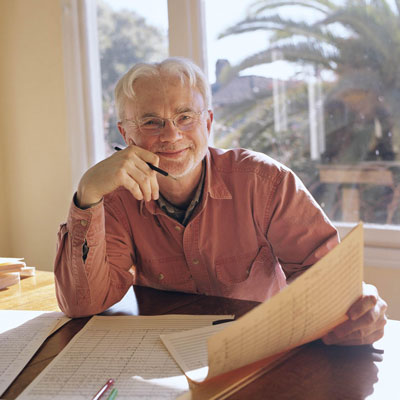John Adams

- Born: February 15, 1947 in Worcester, Massachusetts
El Niño, A Nativity Oratorio
“I love Messiah,” declared John Adams. “I always wanted to write my own Messiah. I loved Handel’s music but not only that, the story itself. I have a somewhat checkered religious background and I wasn’t someone who studied the Bible, but I certainly knew the Nativity and Passion stories. When I was asked to celebrate the millennium [in a co-commission from the Châtelet Theater in Paris, San Francisco Symphony, Lincoln Center in New York, Barbican Center in London, and Deutsches Symphonie in Berlin], the year 2000 seemed like an appropriate date to write a Messiah-type piece. I went to my long-term friend, director Peter Sellars, and said, ‘Let’s put together a libretto about the roughness and the toughness and the difficulty of life,’ and El Niño came into being.”
Though Messiah (especially the Hallelujah Chorus) is inextricably associated with Christmas, its text, drawn, unusually for Handel’s oratorios, entirely from scripture, concerns three fundamental events in the Christian liturgical year—The Advent of the Messiah, The Passion of Christ, and His Resurrection. Adams’ choice to write specifically a “Nativity Oratorio” arose not from just his love of Handel, however, but also from the profound experience of the miracle of own his daughter’s birth in 1984—”There were four people in the room, and then there were five.” So in addition to its biblical associations, El Niño was also motivated by what Adams termed “the story of birth—not just the birth of Jesus, but the archetypical experience of a woman giving birth.” (“El Niño” in the context of this work refers specifically to the Christ Child, but Adams and Sellars were both keenly aware, even in the year 2000, that the phrase “El Niño” also refers to the phenomenon of Pacific Ocean warming that has had increasingly disruptive effects on climate around the world.)
Adams and Sellars created the libretto for El Niño, about a third of it in Spanish or Latin, by complementing traditional Nativity verses from the King James Bible with texts from the New Testament Apocrypha, the Wakefield Mystery Play (from England), and Martin Luther’s Christmas Sermon, as well as poems by Rosario Castellanos (Mexico, 1925-1974, the country’s ambassador to Israel), Gabriela Mistral (Chile, 1889-1957, the first Latin American author awarded a Nobel Prize), Vicente Huidobro (Chile, 1893-1948, an influential avant-gardist), Rubén Darío (Nicaragua, 1867-1916, founder of the Latin American modernismo literary movement), and the Mexican philosopher, composer and nun Sor Juana Inés de la Cruz (1648-1695, condemned by authorities for advocating education for women); the Latin hymn O quam preciosa (“O how precious”) by the 12th-century abbess, visionary, prophet, poet and composer Hildegard von Bingen closes Part I of the oratorio.
The one movement that stands apart from the Christmas story is Memorial for Tlatelolco, set to a poem by Rosario Castellanos, which Adams and Sellars used to draw a modern parallel to Herod’s massacre. Tlatelolco is a neighborhood of Mexico City that was the site of a protest on October 2, 1968 by thousands of Mexican students against repressive policies of the Mexican government. Though the demonstrators were peaceful and unarmed, they were surrounded by armored vehicles, jeeps and 5,000 soldiers. Shots, probably from the government forces, rang out, chaos ensued, and as many as 400 demonstrators were killed; 1,345 were arrested. Castellanos captured the essence of the tragedy not just in the angry, stupefied lines that comprise most of her poem, but, perhaps most poignantly, in its mundane references: Dawn broke on the plaza cleanly swept;/the newspapers spoke of the weather as their main story./And on the television, on the radio,/and in the cinema there was no change of program,/no interrupting news bulletin nor even/a minute of silence…. I remember. We remember.
The orchestra in El Niño creates a world of sonorities — from the ethereal whispers before the dawn, to the violence of “Memorial to Tlatelolco” that make frighteningly real the murder of hundreds of students in a Mexico City square two millennia later. The three soloists — soprano, mezzo-soprano and baritone—generally sing the words of the story’s characters, though they are not locked into them: both female soloists, for example, represent Mary. The chorus takes on a number of roles—voicing the shouts of the mob; proclaiming a communal article of faith; murmuring in the background an affirmation of Mary’s words; representing “all nations”; even synchronizing with the orchestra to virtually make the instruments speak. The countertenor usually narrates the story, though they also act as a commentator and occasionally take over the words of the characters.
The oratorio as a genre originated in 16th-century Rome when a Dominican priest named Filipo Neri invited a small group of laymen to his quarters to pray and discuss religious matters. Increasing attendance at these gatherings necessitated moving them to the church’s loft, which was subsequently remodeled and re-christened an “oratory”—a “prayer hall.” The highlight of the year for these oratorian groups occurred on the Fridays of Lent, when elaborate ceremonies with much music drew large audiences, and by the 1620s, had come to include the telling of a biblical story appropriate for the Lenten season through the techniques of the revolutionary genre of opera—recitative, solo singing supported by instrumental accompaniment, choruses, vocal ensembles. Thus was born the “oratorio,” a tradition that George Frideric Handel learned during his years in Italy (1706–1710). Like Handel’s oratorios that trace to that tradition of drawing together sacred and secular realms, John Adams’ El Niño renews an endlessly told Bible story by making its timelessness contemporary, its narrative dramatic, and its universality personal.
—Dr. Richard E. Rodda